Colloidal Quantum Dot Nanolithography: Direct Patterning via Electron Beam Lithography
Abstract
1. Introduction
2. Materials and Methods
3. Results and Discussion
3.1. Electron-Beam Exposure Dose Test
3.2. Enhanced Fluorescence of QD Micropatterns
3.3. Direct Patterning of QDs Using E-Beam Lithography
4. Conclusions
Supplementary Materials
Author Contributions
Funding
Data Availability Statement
Conflicts of Interest
References
- Kagan, C.R.; Lifshitz, E.; Sargent, E.H.; Talapin, D.V. Building Devices from Colloidal Quantum Dots. Science 2016, 353, aac5523. [Google Scholar] [CrossRef]
- Yang, Z.; Fan, J.Z.; Proppe, A.H.; García de Arquer, F.P.; Rossouw, D.; Voznyy, O.; Lan, X.; Liu, M.; Walters, G.; Quintero-Bermudez, R.; et al. Mixed-Quantum-Dot Solar Cells. Nat. Commun. 2017, 8, 1325. [Google Scholar] [CrossRef] [PubMed]
- Rong, K.; Gan, F.; Shi, K.; Chu, S.; Chen, J. Configurable Integration of On-Chip Quantum Dot Lasers and Subwavelength Plasmonic Waveguides. Adv. Mater. 2018, 30, e1706546. [Google Scholar] [CrossRef]
- Li, P.; Zhang, X.; Li, Y.; Qi, L.; Tang, C.W.; Lau, K.M. Monolithic Full-color Microdisplay Using Patterned Quantum Dot Photoresist on Dual-wavelength LED Epilayers. J. Soc. Inf. Disp. 2021, 29, 157–165. [Google Scholar] [CrossRef]
- Kim, Y.; Bicanic, K.; Tan, H.; Ouellette, O.; Sutherland, B.R.; García de Arquer, F.P.; Jo, J.W.; Liu, M.; Sun, B.; Liu, M.; et al. Nanoimprint-Transfer-Patterned Solids Enhance Light Absorption in Colloidal Quantum Dot Solar Cells. Nano Lett. 2017, 17, 2349–2353. [Google Scholar] [CrossRef]
- Segkos, A.; Sakellis, I.; Boukos, N.; Drivas, C.; Kennou, S.; Kordatos, K.; Tsamis, C. Patterned Carbon Dot-Based Thin Films for Solid-State Devices. Nanoscale 2020, 12, 10254–10264. [Google Scholar] [CrossRef] [PubMed]
- Yang, J.; Hahm, D.; Kim, K.; Rhee, S.; Lee, M.; Kim, S.; Chang, J.H.; Park, H.W.; Lim, J.; Lee, M.; et al. High-Resolution Patterning of Colloidal Quantum Dots via Non-Destructive, Light-Driven Ligand Crosslinking. Nat. Commun. 2020, 11, 2874. [Google Scholar] [CrossRef] [PubMed]
- Myeong, S.; Chon, B.; Kumar, S.; Son, H.-J.; Kang, S.O.; Seo, S. Quantum Dot Photolithography Using a Quantum Dot Photoresist Composed of an Organic-Inorganic Hybrid Coating Layer. Nanoscale Adv. 2022, 4, 1080–1087. [Google Scholar] [CrossRef]
- Mei, W.; Zhang, Z.; Zhang, A.; Li, D.; Zhang, X.; Wang, H.; Chen, Z.; Li, Y.; Li, X.; Xu, X. High-resolution, full-color quantum dot light-emitting diode display fabricated via photolithography approach. Nano Res. 2020, 13, 2485–2491. [Google Scholar] [CrossRef]
- Cho, S.-Y.; Jeon, H.-J.; Yoo, H.-W.; Cho, K.M.; Jung, W.-B.; Kim, J.-S.; Jung, H.-T. Highly Enhanced Fluorescence Signals of Quantum Dot-Polymer Composite Arrays Formed by Hybridization of Ultrathin Plasmonic Au Nanowalls. Nano Lett. 2015, 15, 7273–7280. [Google Scholar] [CrossRef]
- Dieleman, C.D.; Ding, W.; Wu, L.; Thakur, N.; Bespalov, I.; Daiber, B.; Ekinci, Y.; Castellanos, S.; Ehrler, B. Universal direct patterning of colloidal quantum dots by (extreme) ultraviolet and electron beam lithography. Nanoscale 2020, 12, 11306–11316. [Google Scholar] [CrossRef] [PubMed]
- Dement, D.B.; Quan, M.K.; Ferry, V.E. Nanoscale Patterning of Colloidal Nanocrystal Films for Nanophotonic Applications Using Direct Write Electron Beam Lithography. ACS Appl. Mater. Interfaces 2019, 11, 14970–14979. [Google Scholar] [CrossRef] [PubMed]
- Liu, Y.; Han, F.; Li, F.; Zhao, Y.; Chen, M.; Xu, Z.; Zheng, X.; Hu, H.; Yao, J.; Guo, T.; et al. Inkjet-Printed Unclonable Quantum Dot Fluorescent Anti-Counterfeiting Labels with Artificial Intelligence Authentication. Nat. Commun. 2019, 10, 2409. [Google Scholar] [CrossRef]
- Keum, H.; Jiang, Y.; Park, J.K.; Flanagan, J.C.; Shim, M.; Kim, S. Photoresist contact patterning of quantum dot films. ACS Nano 2018, 12, 10024–10031. [Google Scholar] [CrossRef]
- Choi, M.K.; Yang, J.; Kang, K.; Kim, D.C.; Choi, C.; Park, C.; Kim, S.J.; Chae, S.I.; Kim, T.-H.; Kim, J.H.; et al. Wearable red-green-blue quantum dot light-emitting diode array using high-resolution intaglio transfer printing. Nat. Commun. 2015, 6, 7149. [Google Scholar] [CrossRef] [PubMed]
- Biswas, S.; Brinkmann, F.; Hirtz, M.; Fuchs, H. Patterning of Quantum Dots by Dip-Pen and Polymer Pen Nanolithography. Nanofabrication 2015, 2, 19–26. [Google Scholar] [CrossRef]
- Ko, J.; Chang, J.H.; Jeong, B.G.; Kim, H.J.; Joung, J.F.; Park, S.; Choi, D.H.; Bae, W.K.; Bang, J. Direct Photolithographic Patterning of Colloidal Quantum Dots Enabled by UV-Crosslinkable and Hole-Transporting Polymer Ligands. ACS Appl. Mater. Interfaces 2020, 12, 42153–42160. [Google Scholar] [CrossRef]
- Wang, Y.; Pan, J.-A.; Wu, H.; Talapin, D.V. Direct Wavelength-Selective Optical and Electron-Beam Lithography of Functional Inorganic Nanomaterials. ACS Nano 2019, 13, 13917–13931. [Google Scholar] [CrossRef]
- Wang, Y.; Fedin, I.; Zhang, H.; Talapin, D.V. Direct Optical Lithography of Functional Inorganic Nanomaterials. Science 2017, 357, 385–388. [Google Scholar] [CrossRef]
- Nandwana, V.; Subramani, C.; Yeh, Y.-C.; Yang, B.; Dickert, S.; Barnes, M.D.; Tuominen, M.T.; Rotello, V.M. Direct patterning of quantum dot nanostructures via electron beam lithography. J. Mater. Chem. 2011, 21, 16859–16862. [Google Scholar] [CrossRef]
- Palankar, R.; Medvedev, N.; Rong, A.; Delcea, M. Fabrication of Quantum Dot Microarrays Using Electron Beam Lithography for Applications in Analyte Sensing and Cellular Dynamics. ACS Nano 2013, 7, 4617–4628. [Google Scholar] [CrossRef]
- Gölzhäuser, A.; Geyer, W.; Stadler, V.; Eck, W.; Grunze, M.; Edinger, K.; Weimann, T.; Hinze, P. Nanoscale Patterning of Self-Assembled Monolayers with Electrons. J. Vac. Sci. Technol. B Microelectron. Nanometer Struct. Process. Meas. Phenom. 2000, 18, 3414. [Google Scholar] [CrossRef]
- Weimann, T.; Geyer, W.; Hinze, P.; Stadler, V.; Eck, W.; Gölzhäuser, A. Nanoscale Patterning of Self-Assembled Monolayers by e-Beam Lithography. Microelectron. Eng. 2001, 57–58, 903–907. [Google Scholar] [CrossRef]
- Dong, J.; Zhang, Z.; Zheng, H.; Sun, M. Recent Progress on Plasmon-Enhanced Fluorescence. Nanophotonics 2015, 4, 472–490. [Google Scholar] [CrossRef]
- Singh, D.P.; Kumar, S.; Singh, J.P. Morphology dependent surface enhanced fluorescence study on silver nanorod arrays fabricated by glancing angle deposition. RSC Adv. 2015, 5, 31341–31346. [Google Scholar] [CrossRef]
- Herth, E.; Zeggari, R.; Rauch, J.-Y.; Remy-Martin, F.; Boireau, W. Investigation of Amorphous SiOx Layer on Gold Surface for Surface Plasmon Resonance Measurements. Microelectron. Eng. 2016, 163, 43–48. [Google Scholar] [CrossRef]
- Renier, A.; Mangeat, T.; Benalia, H.; Elie-Caille, C.; Pieralli, C.; Wacogne, B. Gold/Silica Thin Film for Biosensors Applications: Metal Enhanced Fluorescence. Laser Phys. 2010, 20, 591–595. [Google Scholar] [CrossRef]
- Kim, D.; Yokota, H.; Taniguchi, T.; Nakayama, M. Precise Control of Photoluminescence Enhancement and Quenching of Semiconductor Quantum Dots Using Localized Surface Plasmons in Metal Nanoparticles. J. Appl. Phys. 2013, 114, 154307. [Google Scholar] [CrossRef]
- Chen, C.; Zhang, L.; Yang, M.; Tao, C.; Han, Z.; Chen, B.; Zeng, H. Size and Distance Dependent Fluorescence Enhancement of Nanoporous Gold. Opt. Express 2017, 25, 9901–9910. [Google Scholar] [CrossRef]
- Kumar, S.; Goel, P.; Singh, D.P.; Singh, J.P. Highly Sensitive Superhydrophobic Ag Nanorods Array Substrates for Surface Enhanced Fluorescence Studies. Appl. Phys. Lett. 2014, 104, 023107. [Google Scholar] [CrossRef]
- Sultangaziyev, A.; Bukasov, R. Review: Applications of Surface-Enhanced Fluorescence (SEF) Spectroscopy in Bio-Detection and Biosensing. Sens. BioSensing Res. 2020, 30, 100382. [Google Scholar] [CrossRef] [PubMed]
- Temirbayeva, D.; Ibrayev, N.; Kucherenko, M. Distance Dependence of Plasmon-Enhanced Fluorescence and Delayed Luminescence of Molecular Planar Nanostructures. J. Lumin. 2022, 243, 118642. [Google Scholar] [CrossRef]
- Abadeer, N.S.; Brennan, M.R.; Wilson, W.L.; Murphy, C.J. Distance and Plasmon Wavelength Dependent Fluorescence of Molecules Bound to Silica-Coated Gold Nanorods. ACS Nano 2014, 8, 8392–8406. [Google Scholar] [CrossRef] [PubMed]
- Li, Y.-Q.; Guan, L.-Y.; Zhang, H.-L.; Chen, J.; Lin, S.; Ma, Z.-Y.; Zhao, Y.-D. Distance-Dependent Metal-Enhanced Quantum Dots Fluorescence Analysis in Solution by Capillary Electrophoresis and Its Application to DNA Detection. Anal. Chem. 2011, 83, 4103–4109. [Google Scholar] [CrossRef]
- Matsuda, K.; Ito, Y.; Kanemitsu, Y. Photoluminescence Enhancement and Quenching of Single CdSe/ZnS Nanocrystals on Metal Surfaces Dominated by Plasmon Resonant Energy Transfer. Appl. Phys. Lett. 2008, 92, 211911. [Google Scholar] [CrossRef]
- Rosebrock, M.; Zámbó, D.; Rusch, P.; Pluta, D.; Steinbach, F.; Bessel, P.; Schlosser, A.; Feldhoff, A.; Hindricks, K.D.J.; Behrens, P.; et al. Spatial Extent of Fluorescence Quenching in Mixed Semiconductor–Metal Nanoparticle Gel Networks. Adv. Funct. Mater. 2021, 31, 2101628. [Google Scholar] [CrossRef]
- Yamamoto, M.; Matsumae, T.; Kurashima, Y.; Takagi, H.; Suga, T.; Takamatsu, S.; Itoh, T.; Higurashi, E. Effect of Au Film Thickness and Surface Roughness on Room-Temperature Wafer Bonding and Wafer-Scale Vacuum Sealing by Au-Au Surface Activated Bonding. Micromachines 2020, 11, 454. [Google Scholar] [CrossRef]
- Mandia, D.J.; Zhou, W.; Ward, M.J.; Joress, H.; Sims, J.J.; Giorgi, J.B.; Albert, J.; Barry, S.T. The Effect of ALD-Grown Al₂O₃ on the Refractive Index Sensitivity of CVD Gold-Coated Optical Fiber Sensors. Nanotechnology 2015, 26, 434002. [Google Scholar] [CrossRef]
- Neff, H.; Zong, W.; Lima, A.M.N.; Borre, M.; Holzhüter, G. Optical Properties and Instrumental Performance of Thin Gold Films near the Surface Plasmon Resonance. Thin Solid Film. 2006, 496, 688–697. [Google Scholar] [CrossRef]
- Fontana, E. Thickness Optimization of Metal Films for the Development of Surface-Plasmon-Based Sensors for Nonabsorbing Media. Appl. Opt. 2006, 45, 7632–7642. [Google Scholar] [CrossRef]
- Saravanan, K.; Krishnan, R.; Hsieh, S.H.; Wang, H.T.; Wang, Y.F.; Pong, W.F.; Asokan, K.; Avasthi, D.K.; Kanjilal, D. Effect of Defects and Film Thickness on the Optical Properties of ZnO–Au Hybrid Films. RSC Adv. 2015, 5, 40813–40819. [Google Scholar] [CrossRef]
- Takekuma, H.; Leng, J.; Tateishi, K.; Xu, Y.; Chan, Y.; Ryuzaki, S.; Wang, P.; Okamoto, K.; Tamada, K. Layer Number-Dependent Enhanced Photoluminescence from a Quantum Dot Metamaterial Optical Resonator. ACS Appl. Electron. Mater. 2021, 3, 468–475. [Google Scholar] [CrossRef]
- Lin, T.J.; Chuang, W.J.; Cheng, S.; Chen, Y.F. Enhancement of Emission from CdSe Quantum Dots Induced by Propagating Surface Plasmon Polaritons. Appl. Phys. Lett. 2009, 94, 173506. [Google Scholar] [CrossRef]
- Ding, Z.J.; Li, C.; Da, B.; Liu, J. Charging Effect Induced by Electron Beam Irradiation: A Review. Sci. Technol. Adv. Mater. 2021, 22, 932–971. [Google Scholar] [CrossRef]
- Wilson, G.; Dennison, J.R. Approximation of Range in Materials as a Function of Incident Electron Energy. IEEE Trans. Plasma Sci. 2012, 40, 291–297. [Google Scholar] [CrossRef]
- Patterson, R.; Kandelbauer, A.; Müller, U.; Lammer, H. Crosslinked Thermoplastics. In Handbook of Thermoset Plastics; Elsevier: Amsterdam, The Netherlands, 2014; pp. 697–737. [Google Scholar]
- Kozawa, T.; Tagawa, S. Radiation Chemistry in Chemically Amplified Resists. Jpn. J. Appl. Phys. 2010, 49, 030001. [Google Scholar] [CrossRef]
- Narasimhan, A.; Wisehart, L.; Grzeskowiak, S.; Ocola, L.E.; Denbeaux, G.; Brainard, R.L. What We Don’t Know about EUV Exposure Mechanisms. J. Photopolym. Sci. Technol. 2017, 30, 113–120. [Google Scholar] [CrossRef]
- Rajput, A.; Kumar, S.; Singh, J.P. Vertically standing nanoporous Al--Ag zig-zag silver nanorod arrays for highly active SERS substrates. Analyst 2017, 142, 3959–3966. [Google Scholar] [CrossRef]
- FDTD. Available online: http://www.lumerical.com/tcad-products/fdtd/ (accessed on 27 February 2023).
- Kumar, S.; Doi, Y.; Namura, K.; Suzuki, M. Plasmonic Nanoslit Arrays Fabricated by Serial Bideposition: Optical and Surface-Enhanced Raman Scattering Study. ACS Appl. Bio Mater. 2020, 3, 3226–3235. [Google Scholar] [CrossRef]
- Axelevitch, A.; Apter, B. In-Situ Investigation of Optical Transmittance in Metal Thin Films. Thin Solid Film. 2015, 591, 261–266. [Google Scholar] [CrossRef]
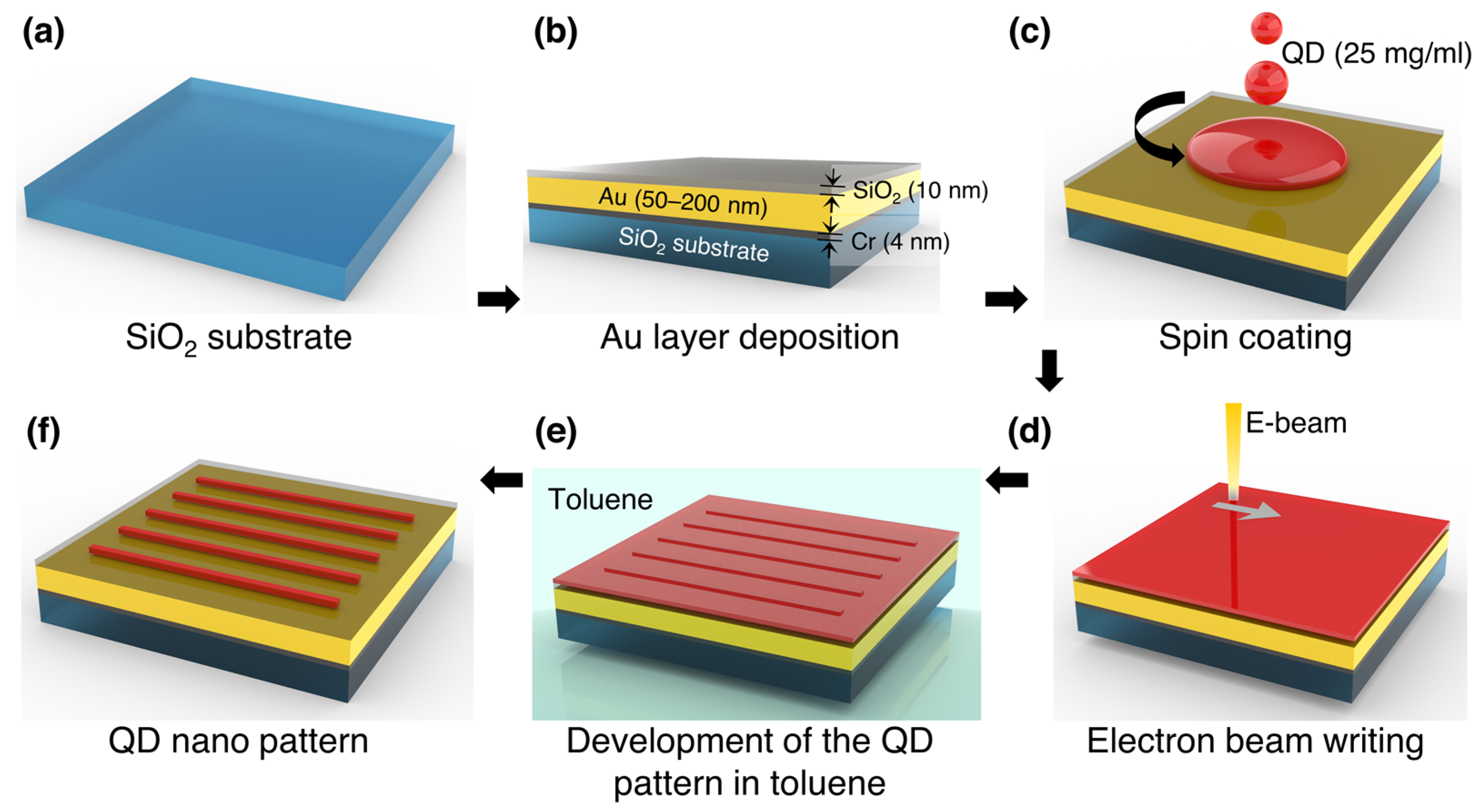
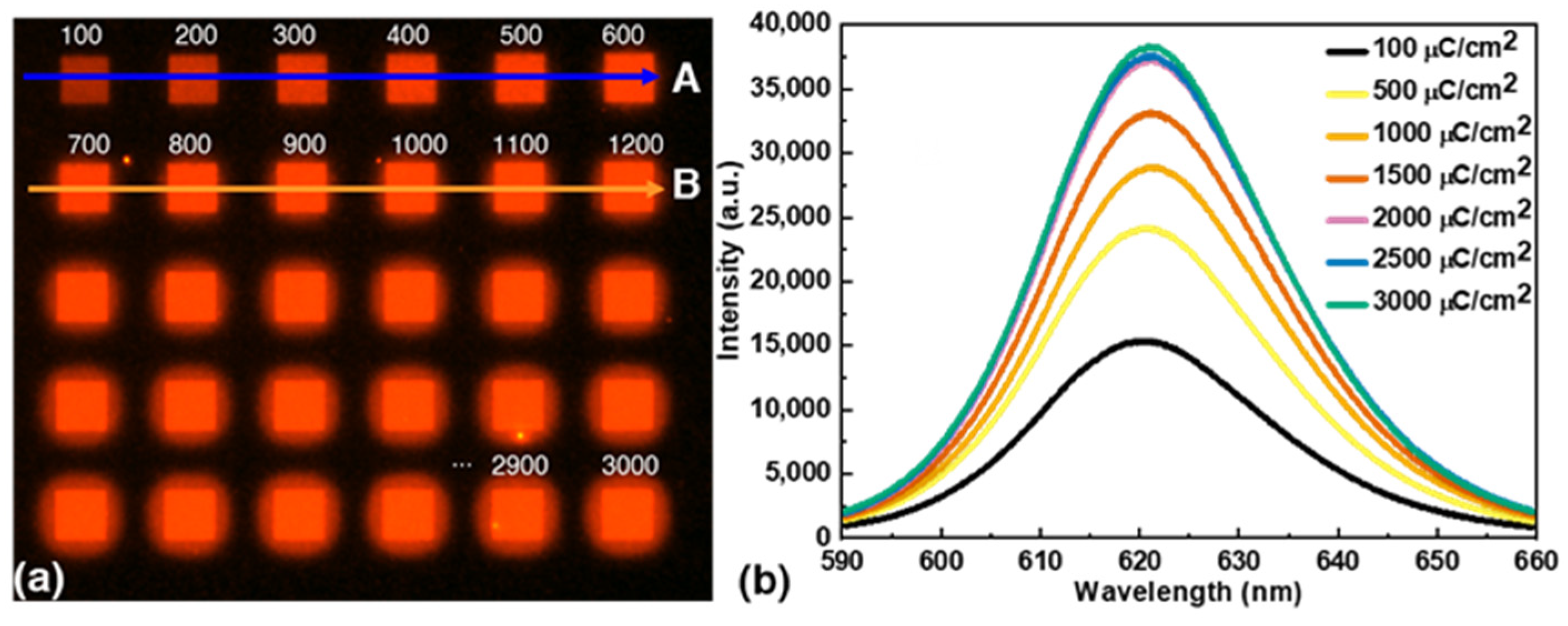
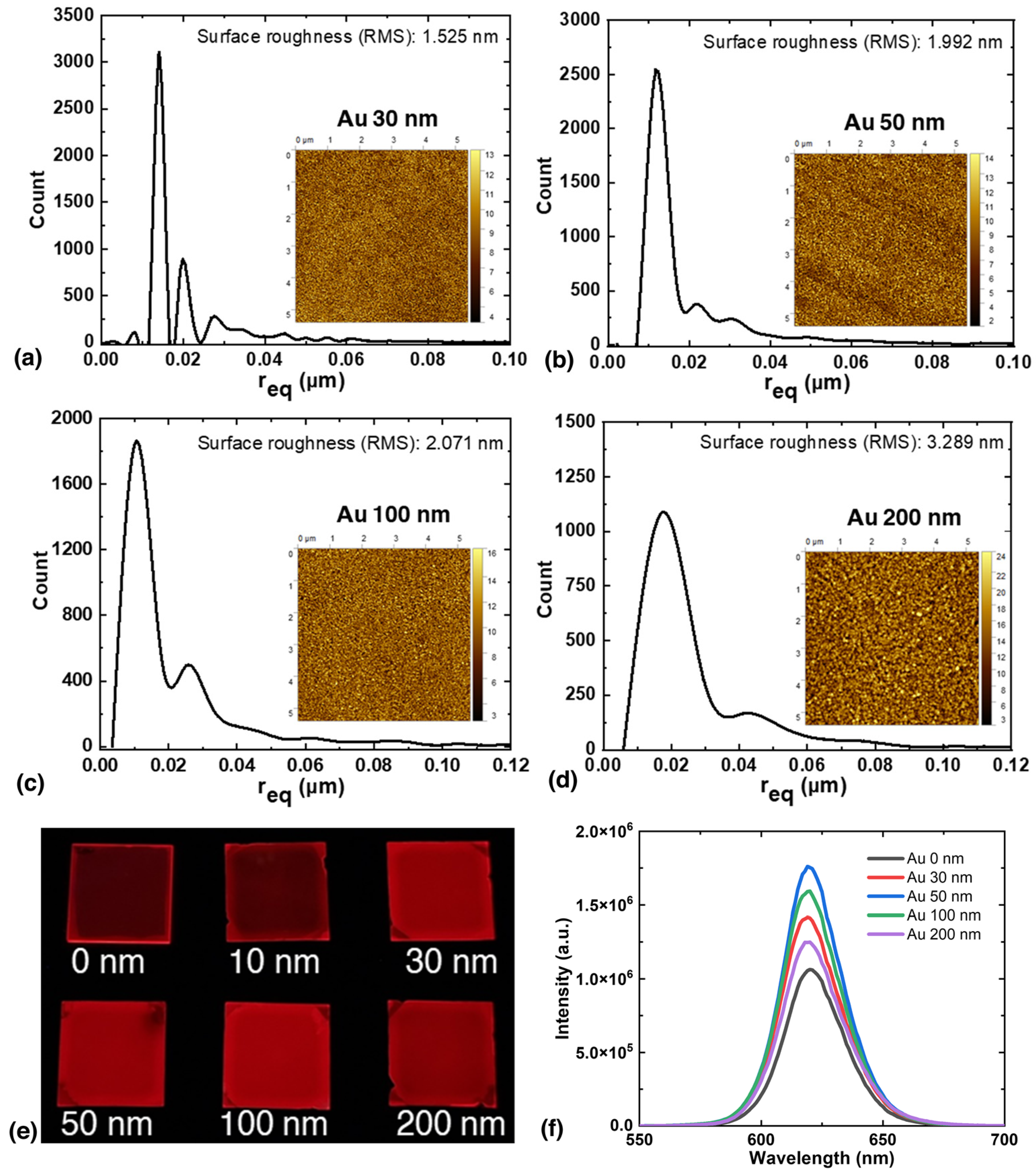
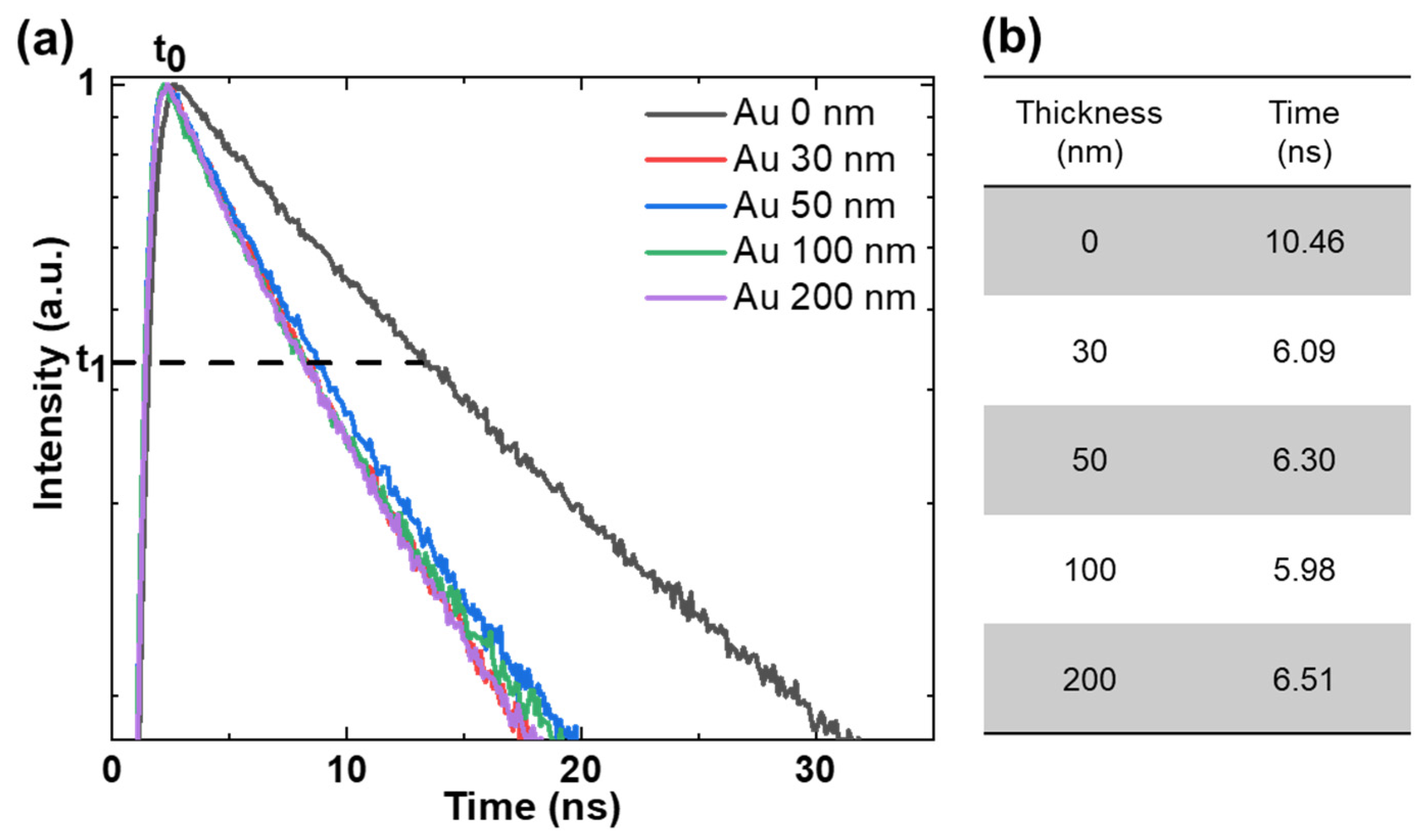
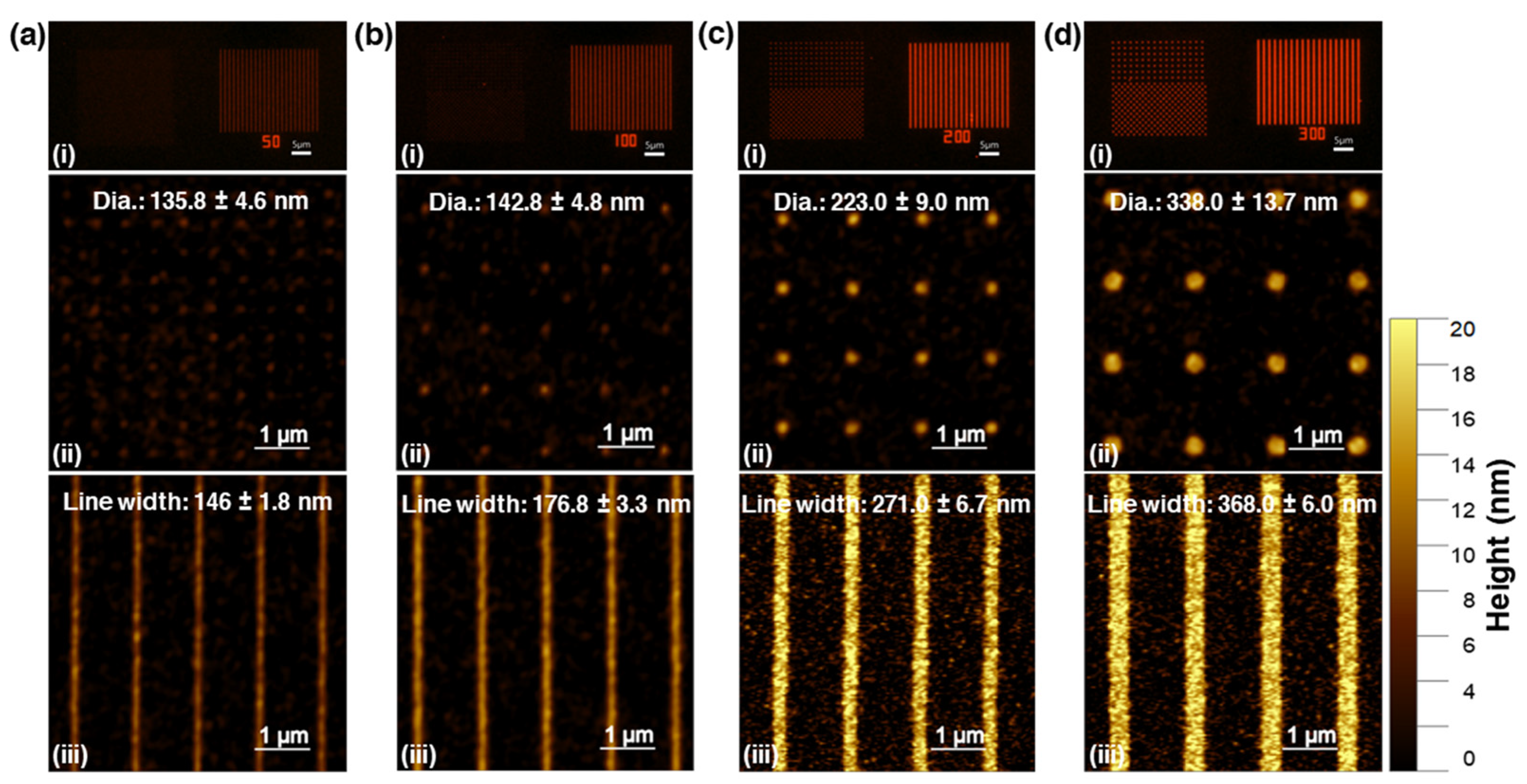

Disclaimer/Publisher’s Note: The statements, opinions and data contained in all publications are solely those of the individual author(s) and contributor(s) and not of MDPI and/or the editor(s). MDPI and/or the editor(s) disclaim responsibility for any injury to people or property resulting from any ideas, methods, instructions or products referred to in the content. |
© 2023 by the authors. Licensee MDPI, Basel, Switzerland. This article is an open access article distributed under the terms and conditions of the Creative Commons Attribution (CC BY) license (https://creativecommons.org/licenses/by/4.0/).
Share and Cite
Ko, T.; Kumar, S.; Shin, S.; Seo, D.; Seo, S. Colloidal Quantum Dot Nanolithography: Direct Patterning via Electron Beam Lithography. Nanomaterials 2023, 13, 2111. https://doi.org/10.3390/nano13142111
Ko T, Kumar S, Shin S, Seo D, Seo S. Colloidal Quantum Dot Nanolithography: Direct Patterning via Electron Beam Lithography. Nanomaterials. 2023; 13(14):2111. https://doi.org/10.3390/nano13142111
Chicago/Turabian StyleKo, Taewoo, Samir Kumar, Sanghoon Shin, Dongmin Seo, and Sungkyu Seo. 2023. "Colloidal Quantum Dot Nanolithography: Direct Patterning via Electron Beam Lithography" Nanomaterials 13, no. 14: 2111. https://doi.org/10.3390/nano13142111
APA StyleKo, T., Kumar, S., Shin, S., Seo, D., & Seo, S. (2023). Colloidal Quantum Dot Nanolithography: Direct Patterning via Electron Beam Lithography. Nanomaterials, 13(14), 2111. https://doi.org/10.3390/nano13142111





